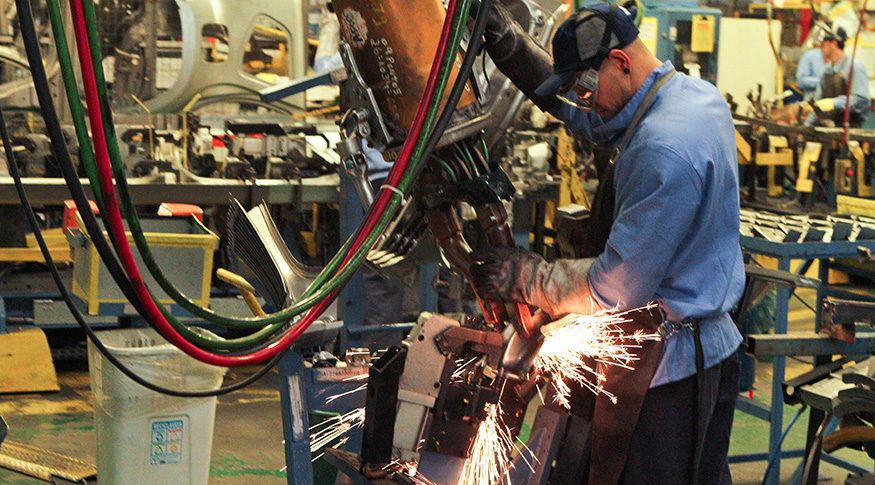Domestic industry
Industrial production shrinks 2.4% in March - second consecutive month of decrease
May 05, 2021 09h00 AM | Last Updated: May 05, 2021 05h28 PM

Industrial production fell 2.4% in March compared to the previous month and intensified the loss of 1.0% that had been registered in February, when there was an interruption of nine months of positive results. The decline in March had a predominance of negative rates among the industrial activities investigated and was mainly driven by the 8.4% drop in the production of motor vehicles, trailers and bodies.
With this month's results, the industrial sector is 16.5% below the record level registered in May 2011. The industry accumulates a 4.4% growth in the year and, in the last 12 months, a 3.1% decrease. The data are from the Monthly Survey of Industry (PIM), released today (5) by the IBGE.
The survey manager, Mr. André Macedo, explains that the deepening of the industrial sector's retreat in March is related to the stricter measures to combat Covid-19. “These two negative results have as background the pandemic's resurgence. This causes greater restriction, which generates less working hours, interruption of activities in industrial plants, affecting the whole production chain, leading to higher prices and a lack of inputs for the production process. This have an impact on the production process as a whole,” he says.
The researcher points out that, from May 2020 to January 2021, there was a cumulative gain of 40.1%, which made industrial production surpass the pre-pandemic level. “In that period, there was a gain of 3.5% above the level of February 2020. But, with the losses of February and March this year, we offset the cumultive figure that we had until January. So the March 2021 level is exactly the same as the pre-pandemic one”, he explains.
Major negative influence among the activities, the sector of Motor Vehicles, trailers and semi-trailers recorded -8.4%, the third consecutive negative result, accumulating in the period a loss of 15.8%. The recent behavior breaks a sequence of eight month of positive rates which accumulated an expansion of 1,196.9%.
"The drop in Motor Vehicles, trailers and semi-trailers was especially affected by the reduction in the production of cars and car parts. this activity had a series of interruptions in the producing processes, shut downs and vacations being granted. That justifies the 8.4% drop", says Mr. Macedo.
The negative influences also include the activities of wearing apparel and accessories (-14.1%), Other Chemical Products (-4.3%), pharmaceutical products (-9.4%), leather, travel goods and footwear (-11.2%), rubber and plastic products (-4.5 %), beverages (-3.4%), furniture (-9.3%), textile products (-6.4%) and non-metallic mineral products (-2.5%).
The main positive impacts came from mining and quarrying industries (5.5%) Other Transportation Equipment (35%) and coke, petroleum products and biofuels (1.7%). "Those activities are offsetting important losses in previous months. They have positive rates this month because the previous losses were very sharp and this is a natural growth", he highlights.
March decrease was accompanied by three f the major economic categories and by most of the segments surveyed. The category semi and non-durable consumer goods fell 10.2%, the greatest loss since April 2020, when it recorded -12.6%. Durable consumer goods (-7.8%), and capital goods (-6.9%) intensified the losses recorded in the previous month. The sector of intermediate goods (0.2%) was the only one to record a positive rate.
Industry grows 10.5% against March 2020
IN the comparison with March 2020, industrial production grew 10.5%, the highest rate since June 2010 (11.2%). This is the seventh consecutive month of growth for this indicator. The researcher explains that the result is due to the low comparison basis, since the sector fell 3.9% in March 2020, and also due to the calendar effect. This year, March had one more work day than last year.
"Against the previous year, industrial production has o=not only recorded a two-digit growth rate, but also very widespread positive rates. However, it is worth mentioning that the comparison basis is low because in March 2020 the industrial sector was already affected by the whole isolation movement due to the Covid-19 pandemic. Much of that wider growth has a direct relationship with it", says Mr. Macedo.
The positive result reached all four major economic categories and most of the activities surveyed. The main influences in this indicator came from motor vehicles, trailers and semi-trailers (19.2%), machinery and equipment (27.5%) non-metallic mineral products (27.7%), metal products (24.5%), rubber products and plastic material (20.3%) and Basic metals (10.9%).
Among the negative influences , the greatest one was coke, petroleum products and biofuels (-1.1%). The activity was pushed by the drop in the manufacture of aviation kerosene, naphthas for petrochemicals, ethyl alcohol and fuel oil.
The segment of capital goods (29.6%) recorded the highest expansion among the major economic categories, followed by durable consumer goods (12.0%), intermediate goods (9.9%) and semi- and non-durable consumer goods (6.2%).
More on the survey
The PIM - Brazil produces short-term indicators since the 1970s related to the behavior of real products of the mining and manufacturing industries. As of May 2014, the new series of monthly indexes of the industrial output began to be released, based on the redesigned Monthly Survey of Industry - Physical Production - PIM-PF. Such redesign aimed at the following objectives: update the sample of activities, products and informants; develop a new weighting structure based on the most recent industrial statistics, as a way to meet the needs of the implementation of the System of National Accounts - reference 2010; and adopt the new classification of activities and products, used in the other industrial surveys since 2007, the National Classification of Economic Activities - CNAE 2.0 and List of Industrial Products - PRODLIST-Industry.
The survey's results can also be seen in the SIDRA database.




















